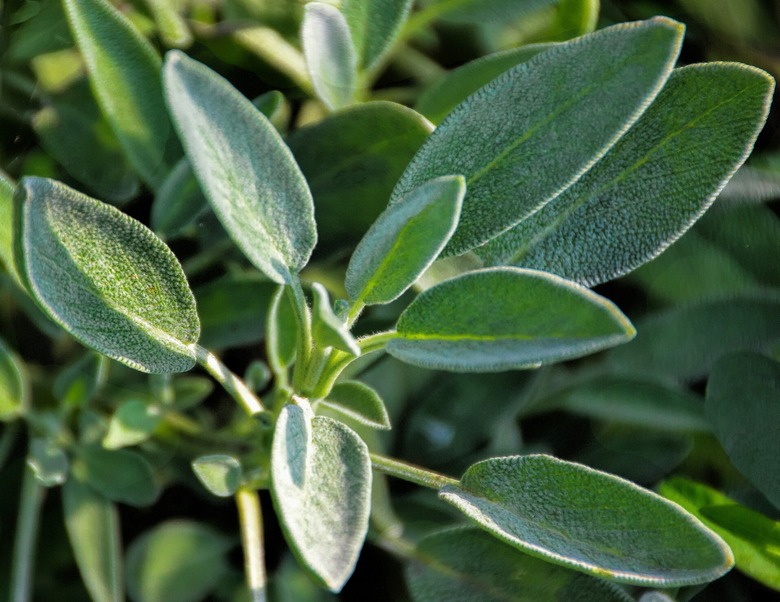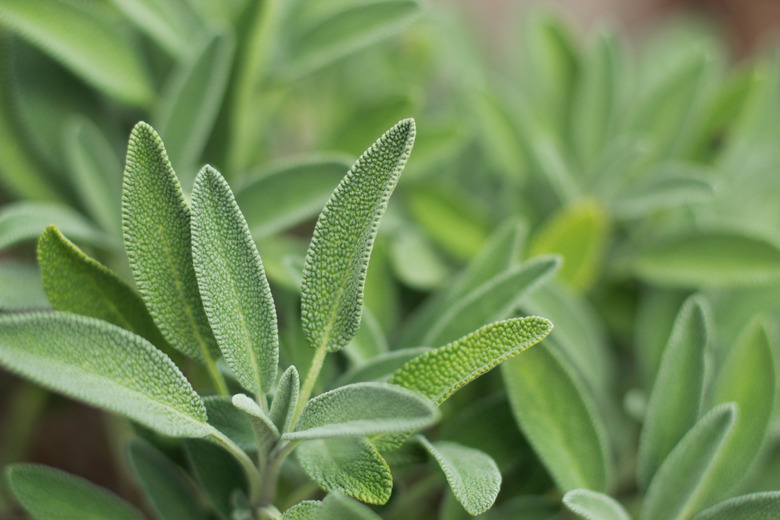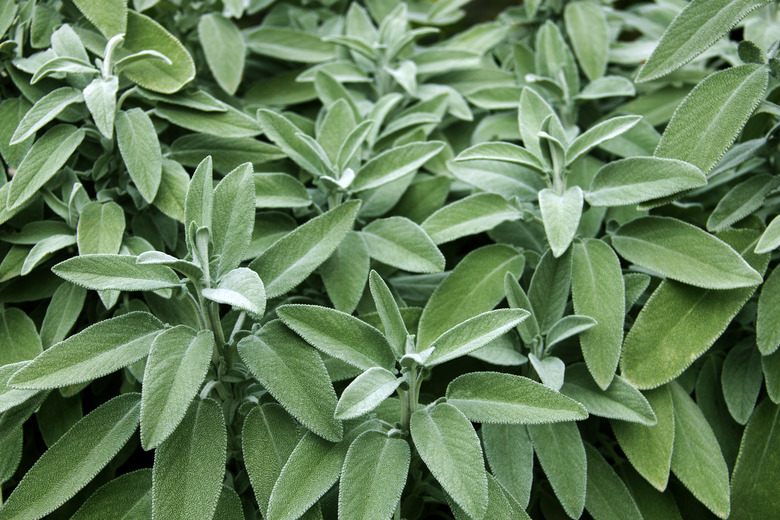How To Grow Sage
We may receive a commission on purchases made from links.
Common sage (Salvia officinalis) is an edible perennial herb that is drought-tolerant, deer-resistant and useful. It is an attractive plant with aromatic, silvery-green leaves and graceful spikes of purple flowers. It provides color and texture in a garden in addition to its culinary and medicinal uses. Sage is an easy-to-grow perennial in U. S. Department of Agriculture plant hardiness zones 4 through 8, and it attracts pollinators to the garden.
Best Uses for Sage
Best Uses for Sage
Sage is among the herbs that multitask. This aromatic member of the mint family (Lamiaceae) is the culinary sage familiar to most cooks. It is useful as seasoning in stuffings as well as other dishes. With its lush foliage and pretty flowers, sage can also grace a perennial garden or vegetable bed instead of being relegated to a dedicated herb garden. Common sage also grows well in a container on the patio in the sun or in a pot on a sunny front porch.
Sage is a sensory delight with its colorful summer blossoms and velvety leaves that carry a strong, minty fragrance. The herb also has medicinal properties. In fact, its genus name, Salvia, comes from the Latin word "salveo," meaning "to save or heal." It has been used in traditional medicines to treat skin and respiratory disorders and has anti-microbial, anti-diabetic and anti-oxidant effects. Some believe that burning sage purifies the area.
Those who are considering installing sage plants in the backyard have many options for this drought-tolerant herb. Sage fits well in an herb garden, but it also adds texture to a flower garden and is perfect in a pollinator garden. It typically grows to 2 feet high with a similar spread. Sage blossoms attract butterflies, bees and even hummingbirds from late spring through autumn. The bright blue or purple flowers are tubular and can grow between 1 and 3 inches long. Sage cultivars are available with pink, white and lavender flowers too.
Starting Sage From Seed
Starting Sage From Seed
Sow sage seeds directly in the ground on or around the average date of the last frost in spring. The soil temperature should be between 60 and 80 degrees Fahrenheit for optimal growth. Alternatively, start the seeds indoors six or eight weeks before the last frost date. In either case, cover the seeds lightly with soil. The seeds should be 1/8 inch below the surface.
The seeds usually germinate in 14 to 21 days as long as the soil is kept moist during that period. If you've started the seeds indoors, set the seedlings in the garden when they are 2 to 3 inches tall. The plants grow quite large, so they should be spaced a full 2 feet apart. They require regular irrigation until they are mature, which usually means the entire first year.
In What Zone Does Sage Grow?
In What Zone Does Sage Grow?
Sage grows best in U.S. Department of Agriculture plant hardiness zones 4 through 8. However, some experts suggest that it can thrive in warmer areas up to zone 10, depending on cultivar. It certainly does well in San Francisco, which is a zone 10 area. So, if you live in any of these zones, it is definitely worth giving this perennial a try.
When Should You Plant Sage?
When Should You Plant Sage?
Garden sage is a tough and hardy herb that adapts to its circumstances quite well — that's why the period during which you can plant sage is flexible. As long as your soil is well-draining and you've prepared it for seeds, you can plant sage in the ground up to two weeks before the last frost date. However, most experts recommend that the seeds be sown on or after the last spring frost date.
Soil, Sunlight, and Water Recommendations
Soil, Sunlight, and Water Recommendations
Sage isn't a prima donna plant; it's a herb native to the Mediterranean and will accept rocky or sandy soil. However, it does best on loamy soil and absolutely requires good drainage. If you plant sage where its roots are in wet soil, it will rot and die.
When it comes to sunshine, sage is one of the sun-loving herbs. It grows best in a south-facing site that gets direct sun and the more sun, the better. If your garden doesn't offer that much sun, you can still grow sage as long as the site gets between two and six hours of direct sun a day.
Sage is very drought-tolerant once it is mature. Like most herbs, however, it requires regular water during its first year in the ground. After seeding and before germination, the soil should be consistently moist. After it matures, you should still irrigate every 10 days during dry periods.
How to Propagate Sage
How to Propagate Sage
Sage is a member of the mint family; you can tell this by its square stems. That makes it no surprise that like mint, sage is ready, willing and able to grow from cuttings. For sage, take soft-wood cuttings in late spring or summer just after the stems start turning brown. Cut pieces of stem some 6 inches long, trying to get three or four leaf nodes in each cutting. Make the cuts on a diagonal just below a node.
Remove the leaves from the bottom half of the cuttings. Dip the cut end of the cutting in rooting hormones if you like, but this is not strictly necessary since sage roots easily. Plant the cut end in sandy soil or other well-draining planting medium and keep the medium moist. Your cuttings may root in around two weeks.
How to Harvest Sage
How to Harvest Sage
Sage is very versatile. Leaves can be used as a flavoring for tea and also to season meat, vegetables and other dishes. Sage is also one of the classic herbs used for stuffings. So, how do you harvest sage for these purposes?
Generally, gardeners growing sage for culinary purposes will harvest the leaves by pinching them off from the plant. The first year, you should harvest sparingly to allow the plant to fully mature. The plant will be ready to harvest 75 days after planting. From the second year onward, it's a good idea to harvest sage by cutting down a few stalks and then removing the leaves for culinary use. Do this up to three times in a growing season to rejuvenate the plant but complete your harvest before the plant flowers. Never harvest in autumn as the plants prepare for winter.
Most people like to use fresh sage in the kitchen, but you can also store it. Sage can be stored after drying or freezing. To dry sage, cut sprigs and hang them to air dry in a well-ventilated room. Then, store it in tightly lidded jars. It's even more flavorful when stored in the freezer. Leaves can be frozen on a tray and then stored in a plastic zip bag.
Common Pests and Other Problems
Common Pests and Other Problems
Wet soil is the biggest problem for sage. The plant will not survive for very long if the soil is consistently wet, and it is likely to suffer stem or root rot. Prevent this by planting it on well-draining soil or in a raised bed.
Plant sprawl may occur on the edge of flower beds if sage plants get too tall. Prune them or give them some stakes on which to lean.
Aphids attack almost anything with green leaves, and although they rarely do significant damage to sage, they can cause minor issues. Aphids are soft-bodied insects with piercing/sucking parts on their mouths. They pierce the green leaves of sage and suck the juices from the plant. Tackle these pests by spraying them with water from your garden hose.
Whiteflies are tiny white insects that resemble flies. It's very unlikely you'll see one or two. Generally, they appear in a large group on the leaves, and a large infestation can seriously weaken a sage plant. These bugs also have piercing/sucking mouth parts, and like aphids, they suck the juices from a living plant. Look for them on the new growth of a sage plant. For a small infestation, blast off whiteflies with a stream of water from the hose. For a large infestation, use an insecticidal soap spray.
Spider mites are not spiders but arachnids that have many legs like spiders. They are very tiny and can damage a sage plant. You'll be able to tell if this pest is on your plant by looking for webbing and tiny holes in the leaves. As with whiteflies, you have two lines of defense: a powerful blast of water from the hose or insecticidal soap.
Common Diseases for Sage
Common Diseases for Sage
Rust is a fungal disease that causes spots on the leaves of a plant: yellow or white spots on the upper side and rust-colored spots on the underside. Prevent this hard-to-treat disease by spacing your plants well and taking care not to get water on foliage while watering.
Powdery mildew is another fungal disease that is easy to spot, as the plant will appear as though powdered sugar has been spilled over it. Neem oil spray can take care of this issue.
Stem rot and root rot are caused by wet soil. Sage stems get clogged with water and rot from the inside. Check for root rot by digging down into the root area to see if the roots are soft and mushy. To avoid stem rot and root rot, plant sage on well-draining soil or in a raised bed, and water appropriately.
Fungal leaf spot causes black or brown water-soaked spots on the sage leaves. The leaves will yellow, wilt and die. You can prevent this fungal disease by giving the plants enough elbow room for air to circulate around and between them. In addition, always water the plant near the soil and never on the leaves.
Bacterial leaf spot results in waterlogged spots on the leaves. To prevent this disease, sanitize your cutting tools with alcohol before using them.
Crown gall is a bacteria that infects growing sage while it is young. Look for galls or growths that form on the sage plant crown. There is nothing you can do to save a plant that has this disease, so prevent it instead. It is usually transferred from another plant in the garden, but sanitizing your tools will go a long way toward preventing its spread to your sage.


